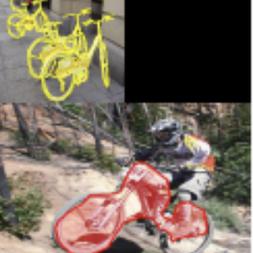Semantic Segmentation
5335 papers with code • 126 benchmarks • 317 datasets
Semantic Segmentation is a computer vision task in which the goal is to categorize each pixel in an image into a class or object. The goal is to produce a dense pixel-wise segmentation map of an image, where each pixel is assigned to a specific class or object. Some example benchmarks for this task are Cityscapes, PASCAL VOC and ADE20K. Models are usually evaluated with the Mean Intersection-Over-Union (Mean IoU) and Pixel Accuracy metrics.
( Image credit: CSAILVision )
Libraries
Use these libraries to find Semantic Segmentation models and implementationsSubtasks
-
 Tumor Segmentation
Tumor Segmentation
-
 Panoptic Segmentation
Panoptic Segmentation
-
 3D Semantic Segmentation
3D Semantic Segmentation
-
 Weakly-Supervised Semantic Segmentation
Weakly-Supervised Semantic Segmentation
-
 Weakly-Supervised Semantic Segmentation
Weakly-Supervised Semantic Segmentation
-
 Scene Segmentation
Scene Segmentation
-
 Semi-Supervised Semantic Segmentation
Semi-Supervised Semantic Segmentation
-
 Real-Time Semantic Segmentation
Real-Time Semantic Segmentation
-
 3D Part Segmentation
3D Part Segmentation
-
 Unsupervised Semantic Segmentation
Unsupervised Semantic Segmentation
-
 Road Segmentation
Road Segmentation
-
 One-Shot Segmentation
One-Shot Segmentation
-
 Bird's-Eye View Semantic Segmentation
Bird's-Eye View Semantic Segmentation
-
 Crack Segmentation
Crack Segmentation
-
 UNET Segmentation
UNET Segmentation
-
 Class-Incremental Semantic Segmentation
Class-Incremental Semantic Segmentation
-
 Universal Segmentation
Universal Segmentation
-
 Polyp Segmentation
Polyp Segmentation
-
 Vision-Language Segmentation
Vision-Language Segmentation
-
 4D Spatio Temporal Semantic Segmentation
4D Spatio Temporal Semantic Segmentation
-
 Histopathological Segmentation
Histopathological Segmentation
-
 Attentive segmentation networks
Attentive segmentation networks
-
 Text-Line Extraction
Text-Line Extraction
-
 Aerial Video Semantic Segmentation
Aerial Video Semantic Segmentation
-
 Amodal Panoptic Segmentation
Amodal Panoptic Segmentation
-
 Robust BEV Map Segmentation
Robust BEV Map Segmentation
Latest papers with no code
A Point-Neighborhood Learning Framework for Nasal Endoscope Image Segmentation
In this paper, we propose a weakly semi-supervised method called Point-Neighborhood Learning (PNL) framework.
Twin Deformable Point Convolutions for Point Cloud Semantic Segmentation in Remote Sensing Scenes
Thanks to the application of deep learning technology in point cloud processing of the remote sensing field, point cloud segmentation has become a research hotspot in recent years, which can be applied to real-world 3D, smart cities, and other fields.
CRIS: Collaborative Refinement Integrated with Segmentation for Polyp Segmentation
Accurate detection of colorectal cancer and early prevention heavily rely on precise polyp identification during gastrointestinal colonoscopy.
Reasoning3D -- Grounding and Reasoning in 3D: Fine-Grained Zero-Shot Open-Vocabulary 3D Reasoning Part Segmentation via Large Vision-Language Models
We design a simple baseline method, Reasoning3D, with the capability to understand and execute complex commands for (fine-grained) segmenting specific parts for 3D meshes with contextual awareness and reasoned answers for interactive segmentation.
Parameter-efficient Fine-tuning in Hyperspherical Space for Open-vocabulary Semantic Segmentation
Since the PEFT strategy is conducted symmetrically to the two CLIP modalities, the misalignment between them is mitigated.
Optimizing Split Points for Error-Resilient SplitFed Learning
Recent advancements in decentralized learning, such as Federated Learning (FL), Split Learning (SL), and Split Federated Learning (SplitFed), have expanded the potentials of machine learning.
Organizing Background to Explore Latent Classes for Incremental Few-shot Semantic Segmentation
During incrementally learning novel classes, the data distribution of old classes will be destroyed, leading to catastrophic forgetting.
Lifelong Learning Using a Dynamically Growing Tree of Sub-networks for Domain Generalization in Video Object Segmentation
However, when DGT is evaluated using in-domain multi-sources, the results show superior performance compared to state-of-the-art video object segmentation and other lifelong learning techniques with an average performance increase in the F-score of 6. 9% with minimal catastrophic forgetting.
Enabling Visual Recognition at Radio Frequency
This paper introduces PanoRadar, a novel RF imaging system that brings RF resolution close to that of LiDAR, while providing resilience against conditions challenging for optical signals.
Learning to Detour: Shortcut Mitigating Augmentation for Weakly Supervised Semantic Segmentation
In this paper, we propose shortcut mitigating augmentation (SMA) for WSSS, which generates synthetic representations of object-background combinations not seen in the training data to reduce the use of shortcut features.































































































































 MS COCO
MS COCO
 Cityscapes
Cityscapes
 KITTI
KITTI
 ShapeNet
ShapeNet
 ScanNet
ScanNet
 ADE20K
ADE20K
 NYUv2
NYUv2
 DAVIS
DAVIS
 SYNTHIA
SYNTHIA
 EuroSAT
EuroSAT